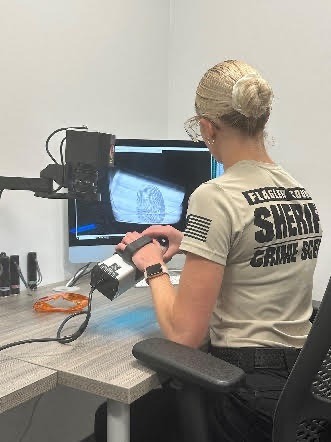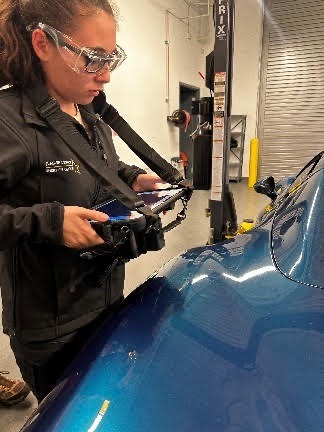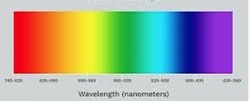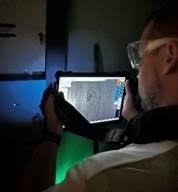The Flagler County Sheriff’s Office now uses the most advanced forensic imaging system to combat crime in Flagler County. The new Arrowhead Forensics Full Spectrum Imaging System II allows crime scene investigators to detect fingerprints on objects and humans in the FCSO Crime Laboratory or at the scene of the crime.

CSI Savannah MacLellan analyzes a fingerprint using the Full Spectrum Imaging System II.
The system combines full-spectrum lighting, high-resolution imaging, and computer processing to create 5K images of fingerprints and biological evidence that were previously undetectable. The imaging system includes a 20-megapixel digital camera with a 50mm lens. Investigators will be able to capture a full print at 1,000 pixels per inch and micro evidence up to 4,800 PPI. Included in the purchase was a portable unit that could be taken directly to a crime scene to process the scene for evidence.
Simply put, this innovative system can locate and capture fingerprints and marks on a variety of layers of a substance in just a few seconds, including glass, metal, wood, paper, thermal paper, and even food items.

FCSO’s CSI Gabbie Massa uses the portable Full Spectrum Imaging System II.
The human eye can only detect light within the visible spectrum, but the FSIS II can reveal evidence from the infrared and ultraviolet spectrums. The technology then converts this information into high-resolution images visible to the human eye.


Visible Light Spectrum Versus Full Light Spectrum
In the past, developing latent fingerprints required the CSI team to use infrared and ultraviolet lights, along with specially filtered glasses, to locate potential prints. They would then use chemical processing techniques to develop and lift the print. This process was long and complex, and it also destroyed the opportunity to obtain DNA evidence from the same item. However, with FSIS II, CSIs can process both latent print and DNA evidence, increasing the solvability of cases.
Sheriff Rick Staly purchased the $135,434.87 system for the FCSO CSI Unit using drug-seized assets.

CSI Supervisor Paolo Santos uses the portable Full Spectrum Imaging System II.
“This new imaging system is a game changer for our CSI team when it comes to locating evidence to help detectives solve crimes faster. We can now detect faint fingerprint evidence or DNA that wasn’t visible before,” said Sheriff Staly “FCSO must stay on the cutting-edge of technology to keep up with criminals and solve crimes, and in this case, Flagler County poison peddlers paid for it because we take a bite out of their profits in crime.”









